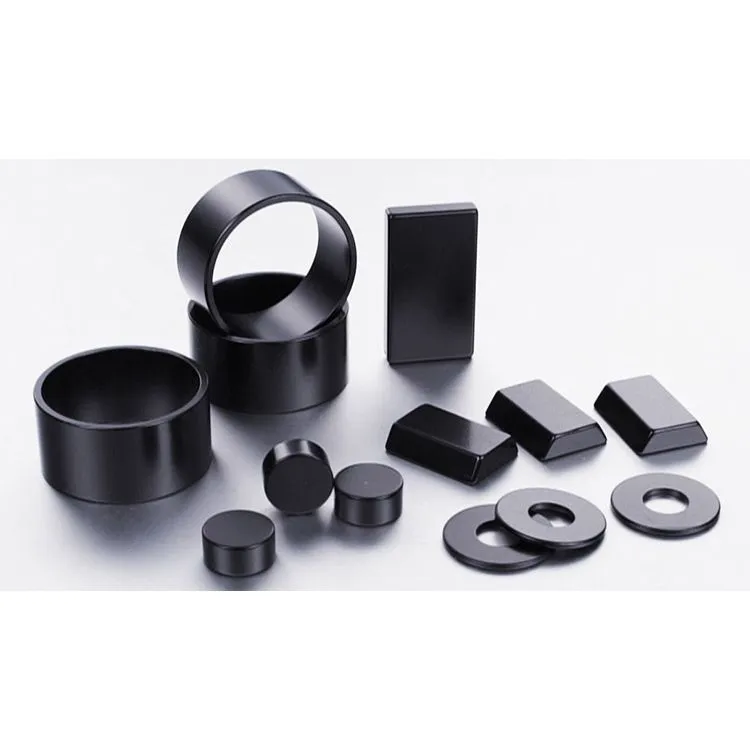What is the difference between sintered and Bonded Neodymium Magnet?
2024-09-18
The difference between sintered and bonded neodymium magnets lies in their manufacturing processes, properties, and applications. Both types use neodymium, iron, and boron (NdFeB) as the primary material, but their distinct production methods give them unique characteristics.

1. Manufacturing Process:
- Sintered Neodymium Magnets:
- Made through a powder metallurgy process. First, a fine neodymium, iron, and boron powder is pressed into a mold under high pressure. Then, the compacted material is sintered (heated without melting) in a vacuum or inert atmosphere to fuse the particles together.
- After sintering, the magnets are machined to their final shape and coated to prevent corrosion.
- Bonded Neodymium Magnets:
- Produced by mixing neodymium, iron, and boron powders with a polymer or resin binder. The mixture is then either compression-molded or injection-molded to create the magnet.
- The bonded process does not require sintering or post-machining, as the mold defines the final shape.
2. Magnetic Strength:
- Sintered Neodymium Magnets:
- Have higher magnetic strength compared to bonded magnets. The sintering process allows for a more concentrated and aligned magnetic field, resulting in stronger magnetic properties.
- Sintered magnets are currently the strongest permanent magnets available, with very high maximum energy products (up to 50 MGOe).
- Bonded Neodymium Magnets:
- Have lower magnetic strength than sintered magnets due to the presence of non-magnetic binder material, which dilutes the magnetic properties.
- Typically, bonded magnets offer maximum energy products up to around 10-17 MGOe.
3. Shape and Design Flexibility:
- Sintered Neodymium Magnets:
- Have more limitations when it comes to shape complexity. Since they are made by pressing and sintering, achieving intricate designs is difficult. They often require post-processing, like cutting or grinding.
- Machining sintered magnets can be challenging due to their brittleness.
- Bonded Neodymium Magnets:
- Offer greater design flexibility. The molding process allows for the creation of complex shapes, including thin walls, detailed features, and custom geometries.
- No additional machining is required after molding, making it easier to produce complex parts.
4. Durability and Mechanical Properties:
- Sintered Neodymium Magnets:
- Are more brittle and prone to cracking or breaking under stress or impact due to their crystalline structure.
- They require coatings (nickel, epoxy, or other materials) to protect against corrosion, especially in humid environments.
- Bonded Neodymium Magnets:
- Have better mechanical properties, being less brittle and more resistant to breaking or cracking.
- While bonded magnets are more corrosion-resistant than sintered magnets, they still require some protective coating in harsh environments.
5. Temperature Stability:
- Sintered Neodymium Magnets:
- Can typically withstand higher operating temperatures compared to bonded magnets, with some grades working up to 200°C or more.
- Bonded Neodymium Magnets:
- Have lower maximum operating temperatures, usually up to around 120°C, as the polymer or binder materials may degrade under high heat.
6. Cost and Production Volume:
- Sintered Neodymium Magnets:
- Generally more expensive due to the complex manufacturing process and need for post-processing. However, they are more cost-effective in high-performance applications due to their superior magnetic strength.
- Bonded Neodymium Magnets:
- Are cheaper to produce in large quantities, especially for complex shapes and designs, as the molding process is simpler and faster than sintering.
7. Applications:
- Sintered Neodymium Magnets:
- Commonly used in applications that require high magnetic strength, such as electric motors, generators, hard drives, magnetic separators, and medical devices.
- Bonded Neodymium Magnets:
- Typically used in applications where design flexibility, lightweight materials, and lower magnetic strength are acceptable, such as sensors, small motors, and consumer electronics.
Summary:
- Sintered Neodymium Magnets: Stronger magnetic properties, brittle, higher temperature tolerance, and used in high-performance applications.
- Bonded Neodymium Magnets: Weaker magnetism, more flexible in design, better mechanical durability, and cost-effective for complex shapes and high-volume production.
The company’s story started in 1998 with the small after-processing factory in Ningbo. factory business demand is increasing day by day, in order to meet the demand, in 2012, Ningbo New-Mag Magnetic Co. , Ltd expansion and transformation into an company that combine R & D, production, sales and service of magnet supplies.Also with exceptional process-related know-how, we are able to offer you high-quality neodymium magnet and physical properties.
Visit our website at https://www.new-magnets.com/ to learn more about our products. For inquiries, you can reach us at master@news-magnet.com.


